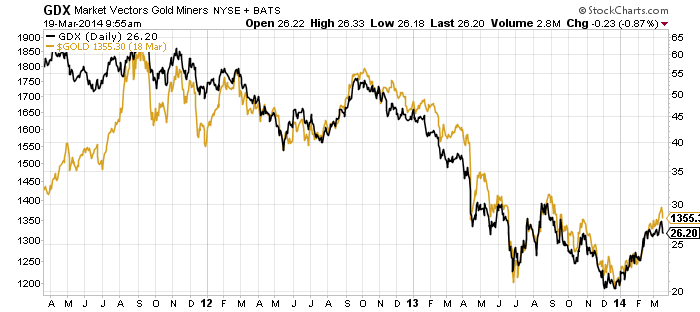As you would expect, the gold price is the tail that wags the gold-mining dog. The tail has been wagging down. Gold has lost significant value over the past 18 months, and so have the gold miners – represented by the Market Vectors Gold Miners ETF (NYSE: GDX). Specifically, the gold price is down 23%; the GDX is down more than 50%.
 Graphs like the one above invariably pique my interest. I like when assets go on sale. Gold and the gold miners are certainly cheaper compared to where they traded a couple of years ago, when the outlook was as detached from reality as any Elvis Presley movie.
Graphs like the one above invariably pique my interest. I like when assets go on sale. Gold and the gold miners are certainly cheaper compared to where they traded a couple of years ago, when the outlook was as detached from reality as any Elvis Presley movie.
[ad#Google Adsense 336×280-IA]Though gold miners are imperfect proxies for physical gold, the correlation in price movement is close enough to offer diversification benefits.
More important from an income-investor’s perspective, gold miners offer a benefit physical gold lacks – cash flow.
I think gold and the gold miners have considerable upside potential.
To be sure, price inflation remains subdued, with the consumer price index (CPI) running at 1.6% annually.
But gold is more than a price-inflation hedge: It’s a store of value and a hedge against uncertainty, which is certainly on the rise thanks to a few belligerent comrades in Ukraine and Russia.
At the same time, the opportunity cost of holding gold remains low. The yield on the 10-year U.S. Treasury note has fallen to 2.7% this year. This means the real interest rate (nominal rate minus the CPI) is only 1.1%. A real interest rate below 2% generally benefits gold.
I see opportunity for investors to pick up gold exposure, cash flow, and price-appreciation potential in three depressed gold-mining stocks. I like these individual stocks because they offer more yield and price-appreciation potential than the GDX.
 Goldcorp Inc. (NYSE: GG) tops the list.
Goldcorp Inc. (NYSE: GG) tops the list.
This miner has considerable girth, with a $22 billion market cap.
Goldcorp’s growth resides in its vast array of development and exploration projects in North and South America.
Management is certainly bullish.
It expects gold production to rise 13% to 18% this year to 3.15 million ounces.
Cost-saving initiatives implemented over the past year will benefit margins. Goldcorp’s all-in cost per ounce should fall between $950 and $1,000 per ounce. This points to Goldcorp maintaining its $0.60 per share annual dividend (paid in $0.05 monthly increments). The board of directors is committed to returning cash to shareholders, having maintained the dividend during the perilous decline in the physical gold price last year. Goldcorp yields 2.3%.
Though a more diverse miner than Goldcorp – with copper, silver, molybdenum, silver, and cobalt properties – Freeport-McMoRan Copper & Gold (NYSE: FCX) still mines a lot of gold. Management expects to mine 1.7 million ounces of it in 2014.
Risk mitigation is the upside to diversification. Freeport reported 2013 EPS of $2.64, which easily covered the $1.25 annual dividend. EPS is expected to increase to $2.79 in 2014, and to $3.14 in 2015. EPS growth bodes well for dividend and share-price growth. Freeport shares yield 4% on its discounted price. I don’t expect the discount to hold through 2014.
I usually bypass a stock after a dividend cut, but Newmont Mining (NYSE: NEM) is worth considering, nonetheless. Newmont reduced its dividend four times in the past four quarters, but this was after increasing the dividend from 2009 through early 2013. The dividend still yields 2.5% at its reduced rate.
Dividend cuts appear to be history, and the quarterly dividend appears sustainable at $0.15 per share. Management affirmed as much in the fourth-quarter analysts meeting, saying that the dividend is sustainable with the gold price hovering above $1,200 an ounce.
Newmont shares are down over 50% in the past 18 months and are trading near a five-year low. But of the three recommendations, it has the greatest potential to rise with the gold price. Newmont is the purest gold play, given that 92% of revenue is generated by gold sales.
For contrarian income investors, these three gold miners offer the opportunity to capture not only income but significant price appreciation.
— Steve Mauzy
[ad#wyatt-income]
Source: Wyatt Investment Research
